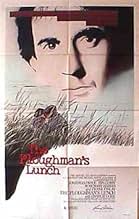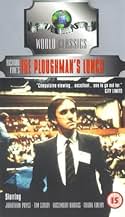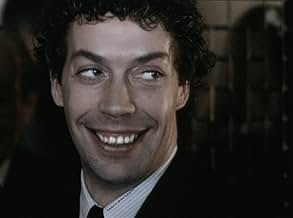NOTE IMDb
6,2/10
526
MA NOTE
Ajouter une intrigue dans votre langueJames Penfield (Jonathan Pryce) has made a career out of journalism. Now bankrupt, he finds himself with a group of other writers in the middle of the dispute-ridden British homeland at the ... Tout lireJames Penfield (Jonathan Pryce) has made a career out of journalism. Now bankrupt, he finds himself with a group of other writers in the middle of the dispute-ridden British homeland at the time of the Falklands War.James Penfield (Jonathan Pryce) has made a career out of journalism. Now bankrupt, he finds himself with a group of other writers in the middle of the dispute-ridden British homeland at the time of the Falklands War.
- Nomination aux 1 BAFTA Award
- 1 victoire et 1 nomination au total
Robert Cartland
- Editor
- (as Bob Cartland)
Histoire
Le saviez-vous
- AnecdotesPart of this movie, towards the end, was set at the Conservative Party annual conference in Brighton in 1982, and was actually filmed at that event. In one shot at the conference, Penfield is seen lighting a cigarette amongst a crowd of conference delegates, and just behind his right shoulder is John Major, who succeeded Margaret Thatcher as Prime Minister.
- GaffesThe film gives thanks to "The Women of Greenham Common," who presumably inspired the peace-camp near where James Penfield (Pryce) gets his flat tyre. The Greenham women's peace-camp had indeed been the first of its kind, near Newbury in Berkshire, and very newsworthy in the early eighties, both for its feminist leadership and its unmovable resistance to the stationing of nuclear weapons - part of NATO's nuclear umbrella initiative - on a site of formerly common land.
However, this would be an entirely illogical route for Penfield to have taken back to London (even to TV studios in W12). He would have had to skirt London anticlockwise to the West on a ninety minute spiral detour along relatively minor roads (the M25 had huge sections yet to be constructed, whilst the M11 was already a swift route from Cambridgeshire toward Central and West London and/or Brixton).
Far more appropriate, given Ian McEwan's strong sense of geographical location, would be a similar peace-camp then starting up just outside RAF Lakenheath near Thetford in Norfolk. Penfield's route from the North Norfolk Coast (by then already popular with arty types seeking a bolthole away from London) would have taken him right past the perimeter early on. From footage of the jets taking off, and the stated fact that the film was "filmed entirely on location in London, Brighton and Norfolk," this seems likely to be the actual location for the filming of that scene.
- ConnexionsReferenced in No 73: The Disagreement (1983)
Commentaire à la une
I am a huge fan of Richard Eyre's work on stage and think he did a masterful job running the National Theatre for all those years. However, both the movies he has directed that I have seen (this one and Iris) are flawed. I think his style of directing might not suit film. There are several passages of the film that neither progress argument, nor develop characters nor set atmosphere effectively.
I am also a big fan of Ian McEwan's writing. This story is full of interesting material. Some of it could come across better - especially the double crossing in the various love interests and the echo of the Suez crisis therein. This might come down to the screenplay or perhaps the directing again.
But stick with it.
The scene in the pub during which Frank Finlay explains to Jonathan Pryce the origins of the ploughman's lunch is superb. The ghastly hermetically sealed cheese chunks on their plates providing a visual to Finlay's words.
We live in a society where we constantly reinvent the past in our attempts to shape the future as we want it. This is a key lesson in the film on all its many levels - the several love interests, Pryce's dereliction of family duty, the Falklands War and the Suez Crisis.
This is a fascinating piece. All the characters are ghastly, especially Jonathan Pryce's well-crafted central character. The standard of acting is consistently high. Despite the flaws, it is well worth seeing.
I am also a big fan of Ian McEwan's writing. This story is full of interesting material. Some of it could come across better - especially the double crossing in the various love interests and the echo of the Suez crisis therein. This might come down to the screenplay or perhaps the directing again.
But stick with it.
The scene in the pub during which Frank Finlay explains to Jonathan Pryce the origins of the ploughman's lunch is superb. The ghastly hermetically sealed cheese chunks on their plates providing a visual to Finlay's words.
We live in a society where we constantly reinvent the past in our attempts to shape the future as we want it. This is a key lesson in the film on all its many levels - the several love interests, Pryce's dereliction of family duty, the Falklands War and the Suez Crisis.
This is a fascinating piece. All the characters are ghastly, especially Jonathan Pryce's well-crafted central character. The standard of acting is consistently high. Despite the flaws, it is well worth seeing.
- ian_harris
- 7 mai 2003
- Permalien
Meilleurs choix
Connectez-vous pour évaluer et suivre la liste de favoris afin de recevoir des recommandations personnalisées
Détails
- Date de sortie
- Pays d’origine
- Langue
- Aussi connu sous le nom de
- The Ploughman's Lunch
- Lieux de tournage
- Sociétés de production
- Voir plus de crédits d'entreprise sur IMDbPro
Contribuer à cette page
Suggérer une modification ou ajouter du contenu manquant

Lacune principale
By what name was Guerres froides (1983) officially released in Canada in English?
Répondre





























